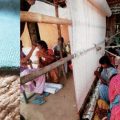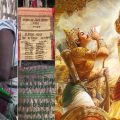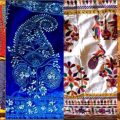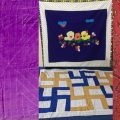Woven wonders of Chinnalapatti and Thirubhuvanam
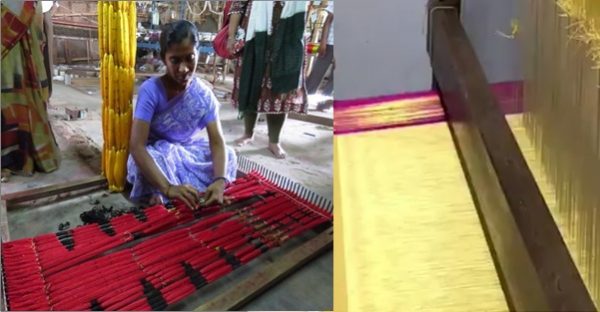
Chinnalapatti Sarees
After Odisha, I am in search of Ikat again, this time in Tamil Nadu! The weavers of Chinnalapatti, a small town near Dindigul have mastered the art of weaving single Ikat sarees. The weaving cluster produces fine, light-weight sarees with Kora Silk Warp and mercerized cotton weft having tie and dye pattern in both body and Pallu using the weft Ikat technique. We are on a trail organised by Co-optex.
Ikat weaving is a recent development in Chinnalapatti. The village was always known for its sarees, but the Chinnala pattus, as they were known were single colour silk sarees with simple gold lines, and were overshadowed by other similar sarees of Tamil Nadu like the Kanchi pattu.
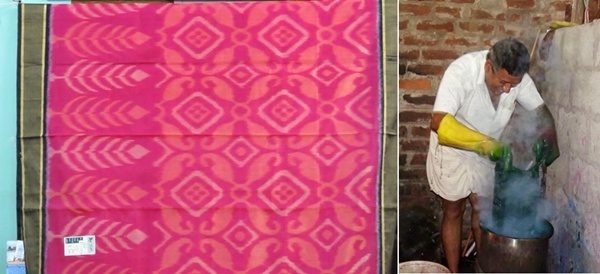
The weavers were despondent and were on the verge of giving up, when the weavers co-op came up with an unique idea a few years ago. They enabled some of their weavers to learn the technique of tie and dye weaving from the Ikat weavers of Puttapaka weaving cluster in Andhra.
It was not easy in the beginning. Tie n dye technique is tricky and the weavers had to first unlearn a lot of their traditional training and learn new techniques. But the dedicated weavers did not give up. Now Chinnalapatti has reinvented itself as the only weaving cluster in Tamil Nadu that weaves Ikat sarees.
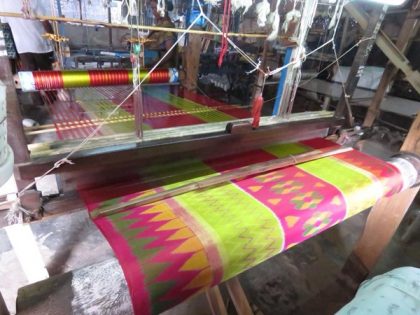
The Chinnalapatti Ikat sarees are famous for their light drape and crispy feel. The uniqueness of the Chinnalapatti Tie and Dye sarees is that mercerized cotton yarn is tied and dyed and used as weft with crispy Kora Silk yarn in the warp.
The technique is the same as Andhra or Odisha Ikat – yarn is first stretched on a grid and tied as per desired motifs. It is then dyed in a vat and then the thread is untied. The area of the yarn covered by thread is left undyed. The process is repeated for each new colour, till desired motif is achieved. The entire process is done completely by hand.
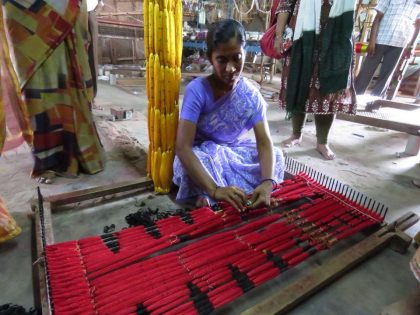
Today, Chinnalapatti has some 4000 people whose livelihood depends on weaving. The sarees woven here are some of the most popular products marketed by Co-optex, the state apex weaver’s co-op. The demand has ensured better wages and a steady income. As a result, you see many young people weaving in Chinnalapatti and that is a welcome sight!!
Thirubhuvanam Pattu Sarees
No Indian bridal trousseau is complete without at least one lustrous Kanchipuram pure silk saree, but how many of us know about the equally gorgeous Thirubhuvanam pattu saree woven in the temple town of Thirubhuvanam near Kumbhakonam?
Thirubhuvanam or ‘Tribhuvan’ silk sarees as they are commonly known, are gorgeous thick three ply silk sarees with one side border woven in real silver or gold jari.
Like Kanchipuram sarees, Thirubhuvanam sarees too are known for the korvai technique, where the body of the saree – the Udal, is joined to the pallu and borders in an intricate labour-intensive interlocking process called korvai’.
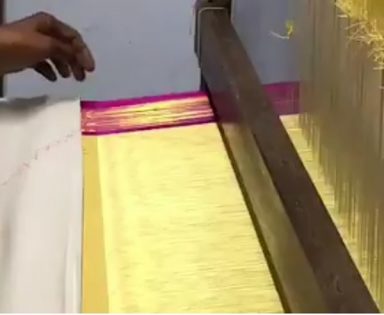
In earlier days, a team of two weavers, either husband-wife or parent-child would work together to do this back-breaking, labour intensive work of joining the saree body and the borders together. But nowadays, the children no longer want to weave and in most cases, it is a single weaver doing the work of two people. This increases the time taken to weave a single saree and slows down the weaver’s speed, affecting his wages.
The Thirubhuvanam saree has typical motifs inspired from the architecture of the nearby imposing Thirubhuvanam Shiva temple, built by the Chozhas. The lions and yalis (composite mythical animals), elephants or yanai, the rudraksham (holy beads) and the annapakshi (swan like bird) chiselled on the temple pillars, all find their place on the borders and buttas on the saree.
Thirubhuvanam sarees are famous for their tapering temple borders inspired by the towering Rajagopuram of the Thirubhuvanam temple. Another distinctive feature of the Thirubhuvanam saree are its distinctive fan like folds.
The Thirubuvanam Silk Handloom Weavers Co-operative Society is the biggest weavers Co-operative Society in Tamil Nadu and employs over 2000 weavers.
Thirubhuvanam sarees are priced from a very affordable 5 K to the really grand full jari brocade sarees that are priced upwards of 100,000! The quality, lustre, softness and the luxurious feel of the sarees is unparalleled. Every Indian woman should aspire to have at least one Thirubhuvanam saree in her wardrobe if she can afford it!
When you buy a Thirubhuvanam saree, it is not merely 5.5 meters of textiles that you own, you own a slice of tradition, culture and spirituality!!

